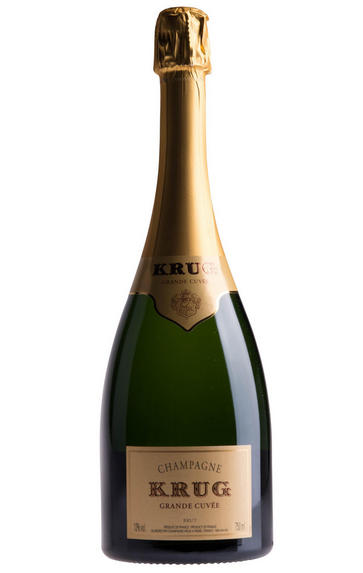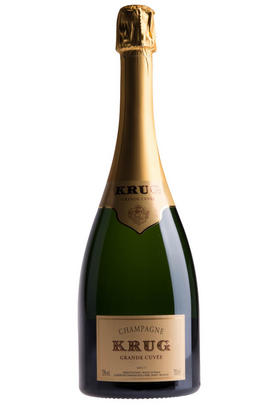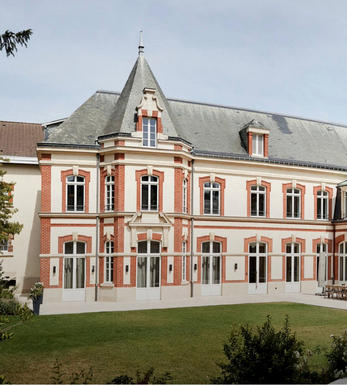
Champagne Krug, Grande Cuvée, 165ème Édition, Brut

Critics reviews
Antonio Galloni, Vinous (July 2018)
About this WINE

Krug
Krug was established in 1843 and has since specialised in producing only prestige and specialised champagnes. Krug is the only firm still producing all its champagne in small oak casks, an essential element for developing Krug's intense bouquet and complex flavours. Today, Henri, Rémi and Olivier Krug, who supervise every step of production, tasting and blending, represent the 5th and 6th generations.
With long periods of maturation (6-8 years), Krug champagne continues to age gracefully after release, developing an intensely rich, nutty flavour whilst remaining remarkably fresh.
Krug`s finest champagne is Clos du Mesnil, a 100%-Chardonnay based champagne that comes from a small walled vineyard at Le Mesnil-sur-Oger. It is one of the world`s greatest Blanc de Blanc champagnes.

Brut Champagne
Brut denotes a dry style of Champagne (less than 15 grams per litre). Most Champagne is non-vintage, produced from a blend from different years. The non-vintage blend is always based predominately on wines made from the current harvest, enriched with aged wines (their proportion and age varies by brand) from earlier harvests, which impart an additional level of complexity to the end wine. Champagnes from a single vintage are labelled with the year reference and with the description Millésimé.
Non-vintage Champagnes can improve with short-term ageing (typically two to three years), while vintages can develop over much longer periods (five to 30 years). The most exquisite and often top-priced expression of a house’s style is referred to as Prestige Cuvée. Famous examples include Louis Roederer's Cristal, Moët & Chandon's Dom Pérignon, and Pol Roger's Cuvée Sir Winston Churchill.
Recommended Producers : Krug, Billecart Salmon, Pol Roger, Bollinger, Salon, Gosset, Pierre Péters, Ruinart

Champagne blend
Which grapes are included in the blend, and their proportion, is one of the key factors determining the style of most Champagnes. Three grapes are used - Pinot Noir, Chardonnay and Pinot Meunier.
26% of vineyards in Champagne are planted with Chardonnay and it performs best on the Côtes des Blancs and on the chalk slopes south of Epernay. It is relatively simple to grow, although it buds early and thus is susceptible to spring frosts. It produces lighter, fresher wines than those from Burgundy and gives finesse, fruit and elegance to the final blend. It is the sole grape in Blancs de Blancs, which are some of the richest long-lived Champagnes produced.
Pinot Noir accounts for nearly 40% of the plantings in Champagne and lies at the heart of most blends - it gives Champagne its body, structure, strength and grip. It is planted across Champagne and particularly so in the southern Aube district.
The final component is Pinot Meunier and this constitutes nearly 35% of the plantings. Its durability and resistance to spring frosts make the Marne Valley, a notorious frost pocket, its natural home. It ripens well in poor years and produces a soft, fruity style of wine that is ideal for blending with the more assertive flavours of Pinot Noir. Producers allege that Pinot Meunier lacks ageing potential, but this does not deter Krug from including around 15% of it in their final blends.


Buying options
Add to wishlist
Description
I imagine the MV Grande Cuvée 165ème will go down as one of the most profound and also perplexing Champagnes in Krug's history. The wine itself, based on the 2009 vintage, is positively stellar. Sensual and powerful, yet with terrific freshness for the year, the 165 is a total knock out. Bright citrus, floral smoke and mineral notes add freshness, tension and energy throughout. It is hard to believe today, but in 2008/2009 Krug went through a very challenging period. Because of the economic crisis, Krug bottled very little Champagne in what will surely be seen as a very shortsighted business decision, if it isn’t already. Production of the 165 is about 1/12th of normal, or the equivalent of one month’s supply, and Krug did not bottle any vintage Champagne. Consequently, the 165 was shipped to just 4-5 markets, including the Unites States, UK and France. Most countries will never see the 165. Readers who have a chance to buy it should not hesitate, as it is likely to become a collector’s item, along with the 2008. Once again, I am reminded of the many conversations I had at Krug about ten years ago. “No one cares about the base vintage in the Grande Cuvée,” numerous people there told me. That’s when I stopped reviewing the Grande Cuvée. How ironic it is that several recent releases have become precisely so coveted because of the base vintage. It is always a mistake to underestimate the consumer.
Antonio Galloni, Vinous (July 2018)
wine at a glance
Delivery and quality guarantee